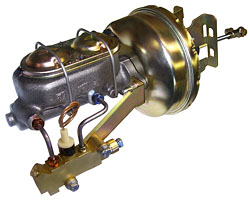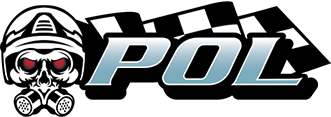
NOTE: Booster may differ from picture depending on type of booster options you have chosen.
STEPS: Read these instructions carefully!
IMPORTANT: This kit is assembled for shipping
purposes only! Be sure to check all nuts and bolts for adequate torque prior to use. Don’t forget!
- Remove original master cylinder, pedal clevis and hard lines.
- Remove master cylinder from power booster as you will need to bench bleed it prior to bleeding the system. Inexpensive bleeder kits are available at any auto parts store for minimal cost. We also sell a bleeder kit. Install your pedal clevis onto booster. NOTE: Booster pushrod may need to be trimmed to fit.
- Install the booster onto the original studs that mounted the master cylinder to the firewall. 1959-65 cars have two studs mounting the master cylinder. You will need to mark and drill the remaining two holes to mount the booster brackets. (NOTE: Some firewall studs were course thread and some were fine thread, you will need to supply the appropriate nuts for the installation!
- You will need to drill a 3/8” hole, 1” lower than the original clevis hole in pedal. Mount the heim joint onto the lower hole with supplied thick washer between the pedal and heim joint. Check for proper adjustment by making sure the brake pedal is all the way up and no pressure is being applied to the booster. Be sure to tighten the heim joint jam nuts. NOTE: 1959-65 cars may already have a second hole in the pedal. Mount heim joint in lower hole. You may need to drill the hole to 3/8”.
- Mount your bench bled master cylinder to the power booster. Connect all appropriate hard lines and bleed the system. NOTE: ON GM MASTER CYLINDERS, THE FRONT PORT IS FOR THE FRONT BRAKES AND THE REAR PORT IS FOR THE REAR BRAKES.
- If you are running disc brakes be sure to have the proper proportioning valve kit for your application.
- Double check all of your work and proceed to check the system for any leaks.
- Be sure to hook up your vacuum line to the appropriate port on the manifold.
Recommendations:
- We highly recommend that you perform a vacuum check on your particular engine. Acceptable vacuum numbers would be from 15in/hg to 22in/hg. For those who have lower numbers we offer a vacuum pump. Call for details.
- We also offer disc brake master cylinders and proportioning valves for those who do not want to run power brakes. Call for details.

I recently bought the ’55-’65 power boost kit. I am not happy with the braking action. The old treadlevac system had 3x the braking power. I was running the disc/drum off of the original treadlevac and had terrific brakes. I decided to upgrade so as to have a proportioning valve. The valve that was sent and installed is described as follows: 2-bottom ports front and rear of the valve. 2 on front END of valve, one with rubber cover and one plugged with brass plug. To properly install, instructions said to connect front(disc) to front of valve and back to rear of valve for rear (drums). Is it possible one should put the disc brakes on the front end of the valve and not on the front port that is on the bottom of the valve???? There has to be something wrong. I have 20 inches of vacuum and the brake pads and shoes are new. Thanks, JIM